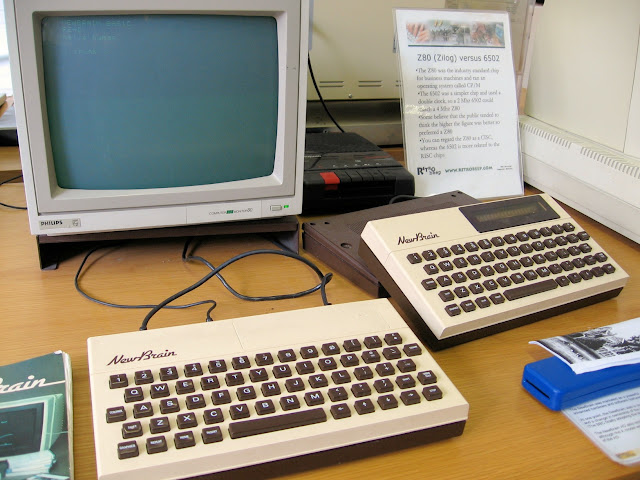Launched July 1982
Largely forgotten today and not even very well remembered at the time, the Grundy NewBrain is one of those microcomputers that could have been a contender in the early 1980s personal computer market.
A compact Z80-based machine, the NewBrain featured exceptionally accurate floating point numbers and very high resolution monochrome graphics, which made it attractive to scientists and engineers. It could output to a monitor and TV, and interestingly most models sold had a 16 character display built into the case itself. Internal memory was split between 32KB of ROM and 32KB of RAM, a typical configuration. Additional paged memory could be added in 64KB blocks, theoretically giving a maximum of 2 megabytes. Expansion options included printers, disk drives and pretty much everything you’d expect for a microcomputer of this era. A portable version was also produced, utilising the inbuilt display plus a battery. The compact size of the NewBrain was due in part to a complex multi-layered motherboard that you tinkered with at your peril.
 |
| Grundy NewBrain |
The hardware is pretty interesting, but the story of the development and eventual demise of the NewBrain is a slice of 1980s technology drama. Originally, the NewBrain was a project at Sinclair Radionics who were looking for a low-cost competitor to the Apple II. However, Sinclair Radionics were looking at a sub-£100 machine and the NewBrain was never going to be that cheap to build. Instead of going forward with the NewBrain, Clive Sinclair instead developed the ZX80 under his other company, Science of Cambridge.
Sinclair Radionics found itself in financial difficulties. This original Sinclair company had developed small radio sets and pocket calculators, but the money ran out and Radionics was rescued by the National Enterprise Board (NEB) who transferred the NewBrain to another NEB-owned company, Newbury Labs.
About this same time, the BBC was starting work on its computer literacy project, which would involve partnering with a manufacturer to create the BBC Microcomputer. The BBC was steered in the direction of the NEB-owned NewBrain which certainly ticked most of the boxes. It should have been a done deal, but when the BBC came calling the NewBrain wasn’t ready… and rival manufacturers had gotten wind of the BBC Micro and had insisted that they be allowed to tender. In the end, Acorn won the tender and their version of the BBC Microcomputer was born.
 |
| Grundy NewBrains with and without integrated displays |
So, the NewBrain missed out on being both a Sinclair machine and a BBC Micro. In the end it ended up with a rather obscure company called Grundy Business Systems, who Newbury Labs sold the design to. It wasn’t an immediate market success, but it looked promising. So promising in fact that Grundy built a lot of them… but the hoped-for sales didn’t appear and by 1983 Grundy was in serious trouble. Essentially by 1983 it was all over, most remaining stocks were liquidated and the NewBrain ended up as a casualty of the early 1980s microcomputer crash.
Although it was a limited success in the UK, it was rather more successful in the Netherlands, Denmark, Greece and – for some reason – Angola. Had it been ready when the BBC were interested then it might have been the first of a series of machines, but in the end the NewBrain’s potential was never realised.
Today these are highly collectible machines, with working systems often commanding prices of £1000 or more. Alternatively, if you are a former NewBrain owner and want to rekindle old memories, then an emulator is available.
Image credits:
Rama & Musée Bolo via Wikimedia Commons - CC BY-SA 2.0 FR
Marcin Wichary via Flickr - CC BY 2.0
